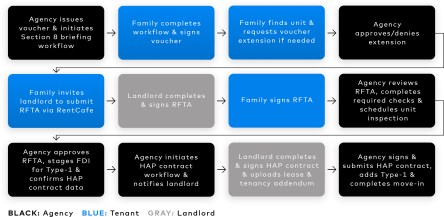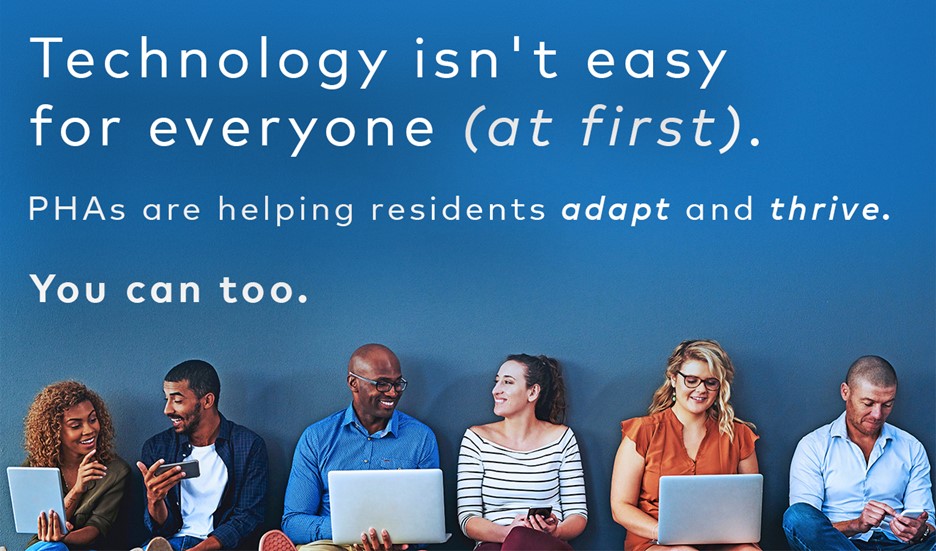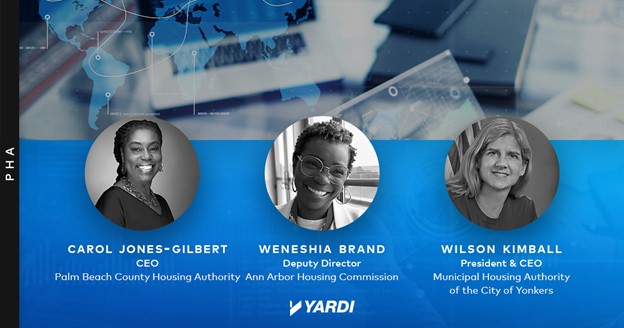Don’t underestimate the power of PHA collaboration. Our team felt inspired by the conversations shared by PHA leaders at YASC. It was a powerful reminder that when we put our heads together, we can work towards common objectives. Navigating the current political climate, interpreting new regulations or even software implementation can be a real headache — especially when you’re going through it alone. But here’s the thing: you don’t have to. Here are some ways you can collaborate with other agencies to strengthen your organization. Stay informed It can be difficult to keep up with HUD and policy changes. The rules are constantly changing, and compliance requirements can feel overwhelming. Chances are that others are feeling the same way. You can host regular meetings or even a group email chains with other PHAs and nonprofits to discuss HUD updates and policy implications. Together, you can interpret new rules and clarify uncertainties. This is all about building consistency across agencies, keeping us moving in the right direction. Stay connected on social media Social media, particularly LinkedIn, is a great place to join others’ PHA collaboration. Following and engaging with your peers’ and industry leaders’ content goes a long way. A simple comment could spark a great conversation or maybe lead to a new connection. You never know until you try! If you haven’t already, be sure to follow Yardi’s new LinkedIn page for Affordable Housing and PHA. You’ll see some familiar faces and get inspired by the ways your peers are successfully using Yardi software. Swap software tips Software dilemmas are just part of the process. From figuring out reporting tools, to inspections, to managing tech challenges, we all go through it at some point. But have you considered that your peers might be dealing...
RFTAs Simplified
Online RFTA explained
Request for Tenancy Approvals (RFTAs) are difficult, but they’re just part of the job. They can take some time and really slow you down when you just want to move things along. The waiting, the delays, the endless paperwork — it all adds up. But there’s a better way. Online RFTA is a tool that saves time for your staff, program participants and landlords. And it all happens electronically through RentCafe PHA. So, no more waiting months for approvals, chasing down lost emails or sifting through heaps of paper. It’s simply a faster way to get things done. How online RFTA works Each step of the RFTA process is handled digitally with Yardi Online RTFA. Agencies issue vouchers, applicants find their units, and landlords execute HAP contracts — all in one digital interface. You may be wondering, do I really need this? Well, this simple tool cuts approval times from weeks to just a few days. Imagine what you could do with the extra time. In fact, Lori McGowen of Spokane Housing Authority praises Yardi’s RFTA portal for just that reason. She says, “We’re able to lease-up in about 10 days rather than 14 to 20 days.” For your applicants, faster approvals mean they can move into homes sooner, and for landlords it could lead to improved ROI and more participation in the program. Finally for your agency, it means greater efficiency and fewer bottlenecks. Take a look at the workflow to see how seamless it is. Then vs. now Maybe spreadsheets and emails are just how you’ve done it all along. And it works. So why change what’s working? Well, think about it this way. What if the time spent on paperwork and follow-ups was time saved? Because when it comes down...
HOTMA Voucher Final Rule...
Impact on PHAs and HCV Programs
As you know, the U.S. Department of Housing and Urban Development (HUD) is constantly keeping us on our toes and for good reason. The HOTMA voucher final rule introduces changes as part of a collective effort to enhance housing stability and address rising rents. For Public Housing Agencies (PHAs), keeping up with HUD changes is key to staying compliant and providing the best possible support to families. Gabrielle Van Horn, senior director at Yardi and an expert in PHA compliance and operations, explains, “Our goal at Yardi is to help PHAs navigate HUD’s evolving requirements. The latest changes reflect greater flexibility and responsiveness in the HCV program.” Let’s take a closer look at these recent changes and how they may impact your agency. Notice PIH 2024-34 HUD recently released Notice PIH 2024-34, which provides guidance for PHAs on Housing Choice Voucher (HCV) payment standards as part of HOTMA voucher final rule. These changes are mandated by the Housing Opportunity Through Modernization (HOTMA) Act of 2016 and are designed to increase flexibility and equity in the HCV program. Relevant changes include how PHAs manage increases and decreases in payment standards, as well as adjustments to family composition and voucher size. Payment standard increase Under the notice, PHAs are now required to implement increases in payment standards during interim reexaminations, rather than waiting until annual reexamination or when moving into a new unit. This adjustment allows families to get help faster when rents go up. If the payment standard increases for households under a Housing Assistance Payments (HAP) contract, they will get the benefit of the new payment standard at the earliest of: A change in the gross rent or family share An interim or annual reexamination One year after the effective date of the new...
Get Ready for the Forum...
Join us April 10-11 in Nashville
The Yardi Affordable Housing and PHA Forum will bring together Yardi clients, team members and industry leaders in a group setting for discussion of challenges and technology solutions. If you are not yet signed up to attend, make plans today! The Forum is happening in Nashville on April 10-11. Get additional details and a link to register. What does the Yardi Forum offer? New this year, the Forum will host panel presentations from affordable housing and PHA industry leaders. Panels will cover topical subjects, including the state of the industry with considerations of changes to funding processes and compliance requirements, such as HOTMA. The core of the Forum agenda is in-person classroom learning. When you attend the Forum, you have a prime opportunity to increase the benefits Yardi solutions can deliver to your agency or affordable housing organization. Forum attendees can choose from 60+ classes, each covering specific Yardi products and/or industry topics. Classes are generally small, taught by Yardi employees, and are set up to encourage questions from attendees. Who should attend the Yardi Forum? As an instructional learning event, the Forum is designed for PHA and affordable housing professionals who use Yardi every day. From front office site staff to accountants and housing compliance specialists (and everyone in between), the Forum is a perfect setting to find new ways to leverage Yardi technology. What benefits will Forum attendees get? Opportunities to learn proper use of Yardi solutions at the Forum go beyond what users may get from online classes, user manuals and independent research. The Forum offers focused sessions that cover topics critical to finding efficiency in the workplace with Yardi technology. Many Yardi clients are familiar with our annual Yardi Advanced Solutions Conference (YASC). While YASC is always a big, exciting...
PHA Employee Training...
Communication Features for Success
Public Housing Agencies (PHAs) are constantly evolving, whether it’s bringing in new talent or refining the skills of seasoned employees. There’s always more to learn, and fresh perspectives can bring valuable insights to your organization. But this ambition to enhance your team comes with the challenges of keeping training materials and employee development organized. That’s exactly where Yardi Aspire steps in. With Aspire, there’s no need to juggle multiple storage systems for training resources and employee documents — it’s all housed in one centralized employee hub. Let’s look at how Aspire simplifies communication and training for PHAs. Personalized dashboards With Aspire, PHA employees get a personalized experience with: Interactive leaderboards: Motivate and engage employees with badge and point rewards Important announcements: Keep your team in the know with training recommendations and policy updates at a glance Training assignments: Assign role-specific courses and easily track progress Interactive training catalog: Provide employee access to a full catalog of PHA-specific courses to ensure compliance and growth Document management Storing and accessing PHA training materials shouldn’t be a challenge — and it shouldn’t even require many clicks or logins either! Aspire’s central hub provides a single source of truth for all essential documents, including: Policy acknowledgment: Track employee acknowledgment with eSignatures and version control Onboarding resources: Simplify new hire onboarding with centralized forms, skills and development checklists Performance reporting: Gain insights into employee performance and training progress with automated tracking Social learning and collaboration tools Collaboration is key to a thriving PHA. Aspire makes team-based learning simple with: Built-in chat tools: Foster peer coaching, group discussions and interactive online training projects. Microsoft Teams integration: Connect Aspire with Teams for a connected training and communication platform Notifications and reminders You can easily help your employees stay on...
PHA Maintenance
A Simple Solution
As public housing professionals, we’re in the business of providing safe and affordable housing. Part of this promise means tackling PHA maintenance issues head-on, whether it’s emergency repairs or various inspections. And with the right software, you can respond to issues as they happen and make life easier for your residents! Here’s how Yardi Maintenance IQ helps you tackle common maintenance challenges: Spike seasons Every public housing authority deals with seasonal maintenance spikes. Whether it’s heating or HVAC repairs, the demand can quickly add up. Maintenance IQ eases the strain of peak seasons by anticipating these demands and helping you allocate resources efficiently. Automated work orders ensure priority request are handles promptly Smart scheduling helps maintenance staff balance workloads and reduce delays With a robust PHA maintenance solution, you can stay ahead of these spike seasons and ensure your residents are taken care of in a timely manner. Emergency repairs Burst pipes, power outages and HVAC failures require immediate attention. And the more time you delay your response, the more costly damages are and the more you are putting residents at risk. With Maintenance IQ, you can streamline repair requests: Tenant submits service requests via in person, by phone or directly from RentCafe Maintenance team receives instant notifications on their mobile device Technicians update work orders, upload photos and complete tasks The difference? Faster response times and improved resident satisfaction! Severe weather events Major weather events have been exacerbated all over the country, and they pose serious challenges for PHAs. Property damage and repairs can truly overrun your maintenance teams, but you can manage this with a robust solution that helps you prepare and respond quickly. Track maintenance trends using data analytics to anticipate weather-related repairs Text functionality keeps tenants updated about work order...
Empowering tech-resistant residents
Strategies for PHAs
We hear it all the time: “Our residents don’t want to use technology.” And we understand why! Concerns range from limited digital access to privacy worries, and sometimes it can be about not feeling comfortable with tech. Their reasons are valid, but with education and community-focused strategies, you can help them break through these barriers. Because when it comes down to it, technology brings a new convenience that residents haven’t experienced before. From paying rent to requesting maintenance, software makes everyday tasks easier and faster. Communicating these benefits can help residents see technology as a helpful tool, rather than a cumbersome task. And once it clicks for them, they won’t go back! This blog will cover: Why technology is critical for PHAs Strategies for adapting tech-resistant residents How Yardi can help your agency succeed Why technology is critical for PHAs In public housing, technology is essential in providing efficient and quality service to residents. Moving away from time-consuming processes, like mailing forms and in-person meetings, simply speeds up operations. And the reality is, online applications and maintenance requests are processed twice as fast as traditional methods, saving you both time and money. Many agencies are already seeing the benefits. By automating tasks, they’re able to allocate resources, reduce backlogs and plan for the future. Read more about how agencies are thriving with technology here. Adapting residents to technology So, how can you adapt tech-resistant residents to feel more comfortable with technology? “In our region, some don’t warm up to technology right away, so we have to go at their pace,” says Stacy Sanders and Marti Chilcoat of the Kentucky Housing Authority. It’s important to have patience and meet residents where there but building comfort with technology also requires education. “Education is key,” says Juan Garcia of the Housing Authority of the County of Santa Barbara. We tell our residents, ‘Hey, with RentCafe you can see your inspections, apply for new waiting lists, review who is your caseworker, submit your paperwork to complete your recertifications easily and best of all it’s available 24/7.’ Once they understand the benefits, they’re more likely to give it a try.” We know how important resident care is to you. Making sure they feel comfortable and confident is imperative to this industry. That’s why it’s important to clarify that technology is only there to support them. 5 strategies to help your resident break the tech-barrier 1. One-on-one meetings: Offering personalized support is a great starting point. Schedule individual meetings to help residents get set up on their device. Allow them to ask questions and be sure to schedule follow-up meetings. “For us, the easiest way is by scheduling resident meetings at move-in to help them get set up on RentCafe on their mobile device.” – Juan Garcia, the Housing Authority of the County of Santa Barbara 2. Group workshops: Hold regular workshops to cover different topics, such as setting up online payments. They can be an inviting way for your residents to learn in a supportive environment. Plus, it gives them a chance to learn and practice together. 3. On-site kiosks: Set up kiosks at your agency or other communal area, where residents can access the technology to complete essential tasks. Having a dedicated space can help residents feel at ease while also providing support for those without a device or access to Wi-Fi. “We set up kiosks in certain locations to make things easier for residents. If they don’t have access to a scanner, they can use the one at our kiosk to upload documents directly into RentCafe.” – Jacquelyn Hicks, vice president of Information Technology at Richmond Redevelopment Housing Authority 4. Wi-Fi help: Inform residents on locations where they can access free Wi-Fi. Limited access is a major barrier, but helping residents understand their options is essential. 5. Step-by-step guides: Written guides or video tutorials are a great way for your residents...
National NAHRO Conference
Event recap
Last week, our PHA team attended the National NAHRO Conference in Orlando, Florida. We especially enjoyed the keynote speech by rapper Roxanne Shante who grew up in Queensbridge Public Housing Projects. Her story highlighted how vital safe and affordable housing is for many artists growing up. It’s inspiring to see icons like Shante actively engage with their community and use their platforms to instill change. A big thank you to our friends at NAHRO for giving us a platform to share how technology can shape the future of public housing. We find it incredibly rewarding to witness the real impact we have on our community and to engage in conversations that challenge us to think and act differently. But we didn’t just share our expertise. We also learned about the inspiring work others in the industry are doing. Our team left the conference feeling more motivated than ever to contribute to this positive change. In case you missed us, here’s a quick recap of what our team covered: Harnessing AI in public housing Jeanette Porter and Jeff Bischoff from Yardi took the stage to discuss a hot topic: AI and its potential in the public housing sector. They explored various uses of AI in housing, such as chatbots and optical character recognition (OCR). We also touched on the importance of safety and security when using AI, especially when handling sensitive personal information. “It’s critical that you have the proper plans, policies and cyber security insurance in place,” said Jeff Bischoff, director at Yardi. Looking ahead, we’re excited about using AI to simplify everyday tasks in public housing. This innovation opens a world of possibilities and we’re eager to keep the conversation going. Streamlining PHA operations with Upfront Income Verifications Next up was Mary Beth Snyder, industry principal at Yardi, who always knows how to engage the crowd and break down the complexities of income verification. Mary Beth explained the new HOTMA rules and how Level 5 Upfront Income Verification is now the highest form of verification since EIV isn’t available at move-in. She pointed out that Level 4 Tenant-Provided Verification can raise fraud concerns, while third-party verification forms have been lowered to Level 3. We also heard from Ebony Bell from the Southern Nevada Regional Housing Authority and Brandi Quiroz from the Corpus Christi Housing Authority. They discussed how their agencies handle to verification and fraud prevention, along with some strategies that have made a real difference for them. We hope to continue empowering housing authorities to streamline their verification processes and maximize staff efficiency. Final thoughts Thank you to NAHRO, Quadel and all the organizations that make this event possible. It was wonderful to see everyone come together, even during a hurricane. We’re grateful our team made it out safely, but our hearts go out to the communities affected by the storm. For more information on Yardi’s public housing solutions, please visit...
Shaping Tomorrow’s PHAs
With Innovation and technology
The housing crisis isn’t going away overnight, but with the power of innovation and technology, people can get housed faster and smarter. That’s why public housing authorities (PHAs) are stepping up to the challenge. We had the privilege of sitting down with some visionary authorities to discuss their plans, and to say we were inspired is an understatement. These agencies understand they need to adapt to meet the changing needs of their community. Leaders in the industry are taking the leap towards implementing technology and transforming their operations — even if it means dipping their feet into an area they aren’t familiar with. By choosing innovation, they’re setting the bar high for public housing authorities — proving that with the right tools and mindset, we can overcome the most daunting challenges. Their commitment to change is paving the way for a brighter future where all families can find safe and affordable housing. “We’re striving to be innovative in our use of technology and development of affordable housing units. We must think outside the box. It’s critical for housing authorities to reinvent themselves and become community leaders. And Yardi has been critical in helping us take that leap,” says Carol Jones-Gilbert, CEO of Palm Beach Housing Authority. In this article, you’ll learn how agencies are using innovation to: Prioritize residents in their operations Navigate the challenges of the PHA world Plan and prepare for the future Putting residents first It’s no secret that there are many moving parts in getting applicants approved for public housing. From managing waitlists to ensuring compliance, the process can be daunting and time-consuming. But agencies are moving forward as technology evolves. Paper processes are a thing of the past, and innovation is the new gold standard. With trusted software, agencies are prioritizing the needs and happiness of their residents. After all, assuring residents receive the support they need is paramount to the goals of public housing agencies. We caught up with Weneshia Brand, deputy director of the Ann Arbor Housing Commission, and discussed her success with Yardi. She explained how they continually strive for excellence in all aspects of their operations and want to set the bar high for other agencies to follow. She championed the simplicity of handling all their business in one platform, including their maintenance, reporting and financial activity. “With Yardi, we can manage our maintenance requests, financial records and compliance reports all in one place,” she offered. These integrations have saved her team hours while also reducing the risk of errors and increasing overall efficiency. But what’s most important is that, with innovation on the rise, agencies can focus on what really matters: the residents. Staff members can now dedicate time to more hands-on tasks, such as maintenance requests, property inspections and personalized support programs. The innovation doesn’t stop here for the Ann Arbor Housing Commission. Brand disclosed her plans to implement Yardi Case Manager. Their interest stems from the desire to be part of the continuum of care. “The case management system will allow us to process our homeless individuals more quickly, ensuring they receive the support they need,” Brand explained. This progressive approach confirms their commitment to leveraging technology to better serve their community and get more people housed. Keeping up with the ever-changing PHA world Public housing agencies are doing incredible work to keep up with the evolving PHA space. They’re navigating a complex web of regulations, adapting to shifting policies and managing staff turnover — all while ensuring their residents are receiving the care they deserve. Let’s be honest, compliance with HUD regulations can cause headaches for many agencies. Navigating the complexities of changing policies at the federal level, staff turnover and compliance work requires dedication and hours of planning. Among these dedicated agencies is the Palm Beach Housing Authority, which has leaned on Yardi to stay compliant and expand the areas they serve. In fact, their...
Succession Planning with Yardi Aspire
For Public Housing Authorities
Public housing authorities (PHAs) across the U.S. are facing a major challenge: many of their employees are getting close to retirement. It’s estimated that over 50 percent of PHA and other public sector employees could retire within the next five years. This means PHAs need to have a plan in place to fill these upcoming vacancies with qualified people. However, it’s not easy — 79 percent of agencies cannot find qualified candidates for open positions, according to a survey by NeoGov, an HR solution provider for the public sector. Succession planning is crucial for PHAs. It’s not just about finding someone to fill a job — it’s about keeping a skilled workforce that can serve their communities effectively. A good succession plan can also lead to better employee retention and engagement. In fact, organizations with strong plans have retention rates 50 percent higher than those without them. To tackle these challenges, PHAs must ensure their staff possess the right skills and knowledge to step into leadership roles when needed. The Yardi Aspire Learning Management System (LMS) is a powerful tool that can help. Aspire delivers effective industry education, skill development and promotion preparation — helping PHAs build a strong pipeline of talent and ensuring smooth leadership transitions. Why succession planning matters Succession planning involves looking ahead and being prepared. According to the HUD Instructional Guide, succession planning helps PHAs in several key ways: Ensures long-term success: Confirms that PHAs maintain smooth service delivery, even during leadership changes. Reduces risks: Identifies important roles and prepares internal candidates when key positions become vacant. Promotes staff growth: Promotes staff development and prepares them for leadership roles, ensuring the right skills are in place. How Aspire supports succession planning Aspire offers several tools that are vital for effective succession planning, such as: Extensive catalog: Offers hundreds of short, interactive courses designed to fit within a busy workday from the LMS or on a mobile device with the Aspire App. The Aspire catalog covers a variety of training topics, including industry knowledge, fair housing and sexual harassment, safety, Yardi software, leadership, professional skills and more. PHAs can also create custom courses to ensure organization-specific learning needs are covered. Assess and develop internal talent: Evaluate your current workforce to identify high-potential employees who could fill key roles in the future with Aspire assessments. Then, map out the key skills needed for each role included in the strategic plan. Configure Aspire to automatically deliver or recommend development opportunities to equip these individuals with the necessary skills and knowledge. These include offering training, mentorship and leadership development assignments — all of which can be set up and tracked in Aspire. IMAGE: Skills assigned report shows a Seattle Housing Authority employee’s progress toward assigned skill proficiency. Custom Learning Plans: Aspire’s embedded authoring tools allow succession plan teams to create custom learning plans that align with their succession goals. These plans clarify the promotion path, which often includes a variety of tasks, learning assignments, forms and surveys and assessments to make sure employees are fully prepared for future roles. External Certifications: Aspire helps PHAs stay compliant with HUD requirements, which is especially important during leadership transitions. In addition to assigning hundreds of short, program-specific courses for Low Income Housing Tax Credit (LIHTC), Section 8, and Enterprise Income Verification (EIV), Aspire clients can upload 3rd party training (i.e., industry certifications) and schedule annual recertification. Comprehensive Reporting: Use the interactive dashboards and scheduled reports to ensure that the required skills and competencies are in place and necessary certifications are up to date. Implementing a succession plan with Aspire Identify Key Roles: Start by identifying the roles that are crucial for your PHA’s operations. Aspire can help document the responsibilities and skills needed for each role. Develop Potential Successors: Use Aspire to create and track personalized development plans for potential successors. These plans can include opportunities to earn badges and rewards, keeping...
Yardi’s HOTMA Plan
Implementing HUD’s changes
Spend time with professionals from the affordable housing space and public housing agencies and you’ll likely hear a timely HUD topic brought up in conversation: HOTMA. It’s a buzz that has many public housing agencies and affordable housing providers asking questions and perhaps feeling concerned about how they will manage to implement new compliance mandates. We met up with Gabrielle Van Horn, Yardi PHA director and Dave Kessler, Yardi vice president of affordable housing, to learn more about HOTMA and what it means for PHAs and affordable housing organizations. They also provide insight on Yardi’s plans to accommodate new compliance mandates that will affect households as they qualify for housing units. Q: First, tell us what HOTMA stands for? Gabrielle: HOTMA is an acronym for the Housing Opportunity through Modernization Act. It was signed into law in July 2016 and goes into full effect on January 1, 2024. Q: What is Congress asking HUD to achieve by implementing HOTMA? Dave: HOTMA is an opportunity for HUD to standardize the way affordable housing programs calculate income. For example, in the past, a household’s calculated income would vary depending on the applicable affordable housing program. Now, with HOTMA, it’s less confusing for housing providers because it standardizes the deductions and exemptions that factor into making a final determination of a household’s income. Gabrielle: Factors such as deductions from income for households with seniors are not only being recalculated, but also standardized across certain programs. That’s good news for programs affected by HOTMA. Q: What should affordable housing providers be working on now to prepare for upcoming changes? Gabrielle: Like anything with HUD, there are aspects of HOTMA that may be a challenge to comprehend and implement. There is a lot to learn and prepare for as the January deadline approaches. Dave: Yardi, as well as other affordable housing and PHA software vendors, is updating our technology to accommodate changes required by HOTMA. We’ll have online coursework for our clients to make sure they remain compliant throughout the process. We are also expecting to soon see HUD’s updates to forms 50058 and 50059, as well as other forms that are directly affected by HOTMA. Once we see those in final format, Yardi will make sure our clients have access to them in our software and that the data fields and calculation formulas are adjusted for HOTMA compliance. Gabrielle: I also want to express that training organizations and nonprofit affordable housing advocacy groups are the best resources for learning about HOMTA. I follow NAHRO’s blog and social media posts for up-to-date information on HOMTA, including training resources they’ve been sponsoring. I recommend this type of training for affordable housing providers and PHAs, and that they get started as soon as possible. Q: What would be an example of an upcoming change? Gabrielle: One that’s sure to help many is the increased income deductions for seniors. Increasing those deductions will make it easier for households to qualify for a unit. It makes sense to make that adjustment now, especially as inflation has increased expenses. Dave: Yes, I’m not sure if HUD expected the pandemic and its residual effects in terms of wage increases when they passed HOTMA in 2016. However, the timing is perfect as it will help households qualify for needed housing resources even as their income may have risen due to high inflation rates over the past few years. Q: How will Yardi software adapt to HOTMA? Dave: We are actively working on updates to Yardi Voyager and Breeze Premier as well as RentCafe, our portal solution for applicants, renters, and private landlords. We’re focused on having that technology ready when our clients are required to adopt HOTMA standards. Gabrielle: We’ve also made additional support staff available so that our clients can get help with Yardi software. But, again, learning HOTMA regulations and compliance mandates is best done with training resources such...
Section 8 Challenges
Solving Voucher Concerns
Most housing assistance available through the Section 8 program is in the form of vouchers. Officially titled Housing Choice Vouchers (HCV), these monthly rent supplements are available to millions of qualified households across the United States to the elderly or who earn very low income in comparison with the median of their community. Jeff Bischoff Households who receive HCV’s may find an apartment they like, sign a lease for whatever the market rate is for that unit, and then pay a portion of the rent on their own. The remainder of the rent, up to a certain amount based on local market conditions, is paid to the landlord via the voucher supplement. HCVs are a great way to disperse renters throughout various parts of the community because they aren’t location based. They can be used to supplement rent payments in any unit that will accept the compliance mandates of the program. Therein lies the main challenge of the HCV program: getting more landlords to choose to rent to households who intend to use a voucher as part of their monthly rent payment. Work to solve this challenge is ongoing. Public housing agencies across the country are using strategies for their local landlords with varying degrees of success. Jeff Bischoff, Yardi’s Senior Director of PHA sales recently spoke about the topic. Read on to hear his thoughts on the challenges of HCVs, and some of the ways his clients are solving them. Tell us what you are hearing from clients about why landlords don’t choose to participate in the HCV program. Bischoff: Landlords seems to be concerned with potential delays in contracting and rent collection. Like every other industry, owners and property managers operate on tight budgets and timeframes. Worrying about losing a month or...
Making Sense of HOTMA
Yardi’s plan for PHAs in 2023
The Housing Opportunity Through Modernization Act (HOTMA) of 2016 brings significant changes to HUD’s public housing program. After years of preparation and implementation processes, public housing agencies across the country are ready to change the way they complete many of their core processes. Yardi is also ready for HOTMA with updates to our PHA Suite in development, as well as a plan to provide hands-on assistance to our clients as we work through HUD’s new program mandates. Gabrielle Van Horn, director of client services for Yardi, recently led an online webinar for Yardi clients walking them through Yardi’s HOTMA strategy. The webinar’s agenda included an overview of HUD changes, notably: Finalization of the Public Housing Over-Income Rule: Section 103 (PIH 2023-3) Final Rule for Sections 102 and 104 HOTMA Implementation Revisions to all 50058 forms Housing Information Portal (HIP), which replaces IMS/PIC National Standard for the Physical Inspection of Real Estate (NSPIRE) Van Horn walked attendees through Yardi’s plan to accommodate these upcoming changes. She also provided a timeline for all Yardi PHA clients who will need to upgrade their software this year, in order to remain compliant with the new HUD rules. Important notes on preparation and training from Gabrielle’s presentation included: Prepare your Board of Commissioners: ACOPs and Admin Plans must be adjusted. These are not optional changes We recommend utilizing training from HUD, industry experts, and industry groups such as NAHRO and PHADA for regulatory guidance An in-person training will be offered at the Yardi Advanced Solutions Conference in San Diego, September 6th – 8th Additional training will be available via online learning and documentation for those unable to attend the conference “This is an all-hands-on-deck process for the PHA client support team over the next few months. We’ve got a plan to help all of our clients to get their software ready for new HUD requirements, and we are allocating resources from within to help make the process as smooth and timely as possible. We’re committed to helping our clients through this process,” said Gabrielle. As a leading provider of PHA software and services, Yardi has access to contacts at HUD to seek clarification and provide feedback on how new rules can be accommodated. Yardi, as well as other vendors, will soon have a private meeting with HUD to discuss particular challenges and to provide advice on implementation strategies. Public housing agencies who are current Yardi clients can log on to Client Central to see Gabrielle’s recorded webinar. Questions submitted during the session, along with answers from Yardi, are also available on Client...
Benefits of e-Signatures...
Many of us have changed the way we go about our daily lives since social distancing efforts began in late 2019. Not only have we rolled with the changes, we’ve embraced them, morphed them into something better, and created new ways to work with each other. A major change affecting affordable housing providers and public housing agencies came in a notice from the United States Department of Housing and Urban Development (HUD) in 2020 by which HUD authorized use of electronic signatures in place of “wet” (i.e. ink) signatures to execute documents for many of its housing subsidy programs. Examples of affected programs include: Project-based Section 8 Rental Assistance Demonstration Project-based Rental Assistance (RAD/PBRA) Section 202 Senior Preservation Rental Assistance Contracts (SPRAC) Section 202/162 Project Assistance Contract (PAC) Section 202 Project Rental Assistance Contract (PRAC) Section 811 PRAC and Project Rental Assistance (PRA) Rent Supplement Section 236 (including RAP) Section 221(d)(3)/(d)(5) Below-Market Interest Rate (BMIR). Why are e-signatures a game changer for subsidized housing? Eliminating ink signature requirements save time and money for affordable housing providers and public housing agencies. Rather that dealing with paperwork, these organizations can now set up digital workflows that reduce paper usage and storage costs. Those online workflows can save significant staff hours and create more time to serve residents. E-signatures are more convenient for affordable housing and PHA applicants and residents. They can execute documents when they have a free moment, instead of taking time off work or from childcare to visit an office to sign forms. Audits are also faster, easier and safer with the use of e-signatures. Because workflows are paperless, auditors can monitor files without having to come into an office. Instead, they can access affordable housing and PHA files from a remote workstation to...
Make the Most of MTW
What’s Next for Participating PHAs
Moving To Work (MTW) was a groundbreaking policy moment for HUD in 1996. Through MTW, HUD selected a small group (or cohort) of public housing agencies (PHAs) for the chance to create their own programs using HUD money. Gabrielle Van Horn speaks at NAHRO last month. The only caveat to these MTW programs was the they must accomplish specific goals set by HUD, including: Finding better ways to use federal funds with emphasis on reducing costs and improving effectiveness and availability of servicesHelping households improve economic self-sufficiency through incentives for participation in job training, education or job search activitiesIncreasing the availability and selection of housing resources for low-income households As a Demonstration Program, HUD share successes and challenges that each PHA participating in MTW experiences. So, MTW is not just a chance for PHAs to help their local communities, but also help other PHAs craft programs that may work elsewhere. MTW’s recent expansion is an opportunity for more agencies to participate in creating and testing innovative housing policies that can revolutionize the subsidized housing industry. That makes this a great time to check in with Gabrielle Van Horn, director of PHA support for Yardi, to get her perspective on MTW’s history and future. Gabrielle, tell us about Yardi’s first involvement with MTW. Our experience goes back more than two decades, all the way back to 2000. From the beginning, we’ve had MTW clients working with programs falling under the categories of administrative efficiencies, rent reform, work requirements and incentive programs. Collaboration with our customers in program design and our working experience with HUD programs have helped make our customers’ visions come to life. Yardi is honored to partner with some of the most progressive agencies in the country. About half of the original MTW agencies are Yardi clients, so we were well positioned to work on the expansion phase of MTW. We have clients in each cohort. We took the initiative to engage with them as soon as possible so that we could support their newly designed programs and make sure they could track data for accounting, household demographics, changes in income and other key information. How does Yardi help track control groups? To me, HUD’s requirement of control groups is one of most interesting components of the MTW Expansion guidelines. Control group data can be quite helpful in testing program design. Tracking non-participating households alongside those that are part of MTW designed programs makes it possible to prove the effectiveness of locally designed programs. That proof will go a long way in the future of public policy design. That’s why Yardi has ensured that control group tracking is a key component of our custom programming for MTW Expansion rent reform clients. Can you give us an update on how Yardi is supporting MTW Expansion 50058s? This is a new 50058 form and a new file format. We’ll be using new technology to submit these 50058s to HUD to HIP (Housing Information Portal). We have been testing and providing feedback to HUD since they first opened their original testing site to vendors. As soon as HUD is ready, we’ll have the interfaces in place to submit them electronically. One of the greatest benefits of having a longstanding relationship with HUD is the trust that we are doing our part. That means that our clients feel comfortable and confident knowing we have designed features that will reflect their vision and meet HUD’s compliance requirements. What do you think is the most exciting cohort? I am very excited about the Landlord Incentives cohort. Finding ways to make the program more appealing to landlords is critical to the future of the Housing Choice Voucher program. Are you prepared for the next MTW cohort? Yes. We have a team of programmers and support staff ready for the next programs that come from our clients. But, here’s an even better question: is the next...
Key KPI in LA
HACLA Supports Students
Yardi is proud to support the community outreach of clients like the Housing Authority of the City of Los Angeles (HACLA). Their non-profit Kids Progress, Inc. (KPI), supports social service programs that enhance quality of life and ensure long-term academic and economic success for residents in HACLA’s public housing developments. Founded in 2002, five core components of KPI’s work include the promotion of workforce development and lifelong learning, education and youth development, health and wellness, safety and security, and civic engagement. The KPI Scholarship program is designed to support the youth living in HACLA’s public housing developments who are heading to college. “We recognize that college is an important tool for financial and social mobility, not only for the youth themselves but for their families as well,” said Jennifer Thomas Arthurs, vice president of KPI and deputy assistant director of strategic initiatives for HACLA. “Yardi has been a long-time partner and supporter of HACLA with its software services as well as through the Section 3 program.” The scholarship program supports and celebrates graduating seniors from HACLA’s Section 8 program and public housing sites who are transitioning to college. This is the first year that Yardi funded scholarships for the program, providing scholarships for three rising college freshmen. The selected scholars, who all live in public housing, will be attending UC Merced, UC Irvine, and Cal Polytechnic State University, San Luis Obispo. Students selected for awards must have a minimum of 2.5 GPA, be active in community service and enrichment activities and submit letters of recommendation as well as essays. The program provides a one-time scholarship to high school seniors who are going to attend either trade/vocational school, 2-year colleges and 4-year colleges. Since 2013, the program has awarded a total of $172,000 in scholarship...
Getting the Job Done
Hagerstown Thrives While Distant
Public housing agencies across the country are open for business, even when their physical offices are closed. Their services and resources are literally vital to the health, safety and welfare of millions of Americans. How do they make it work? Hagerstown Housing Authority (HHA), which serves the city of Hagerstown in Maryland, uses specialized software solutions from Yardi that connect their staff to critical workflows that serve waitlisted households, applicants, participants and residents, and landlords. “The coronavirus is an awful situation, of course, but it has given us an opportunity to help our staff realize the benefits of cloud-based software, as well as online solutions for our applicants and residents,” says Sean Griffith, executive director for HHA. HHA has been serving its residents for more than 65 years. As a high-performing housing authority, as distinguished by the U.S. Department of Housing and Urban Development, HHA owns and/or oversees 1,320 dwelling units in 11 communities and more than 900 Housing Choice Vouchers for use by residents who do not dwell in HHA-owned properties. Approximately 12% of the city’s residents are assisted by HHA housing resources. The waiting list for housing assistance from HHA grows daily as economic variables affect local residents. “There has been a definite uptick in need for housing assistance. Our properties are in demand, and the waiting list for Housing Choice Vouchers is growing,” says Griffith. Using RentCafe PHA, HHA makes it possible for interested households to place themselves on its waiting list. The process is handled completely online without the need for an office visit. That feature is particularly timely for HHA given the circumstances created by the COVID-19 pandemic. The agency went live with the Yardi PHA suite in the spring of 2019 and considers cloud functionality one of the...
How PHAs Simplify and Save
Changing workflows for the better
Public housing agencies are among the busiest organizations in the residential property management industry. There’s a lot going on. Most PHAs have thousands of names on their waiting lists. As names come up for consideration, staff faces hours of detailed work to ensure that that applicants qualify for housing assistance. Once applicants become residents, PHAs and the private landlords participating in their programs are responsible for all the normal property management duties associated with multifamily housing. To top it all off, PHAs are required to continuously report to the U.S. Department of Housing and Urban Development, as well as other state and local government offices, for compliance purposes. Luckily, there’s an app for PHAs that streamlines each of these workflows. RentCafe PHA is a unique solution available only to Yardi clients. By modernizing the way PHAs work with stakeholders, most every stakeholder group benefits. Here’s how. Prospects: RentCafe PHA simplifies how an agency can open its waiting list for new names. The typical frenzy of activity that happens when an agency accepts new names is mitigated since people can join a waiting list online, and without having to turn in a stack of paperwork. RentCafe PHA even offers automated solutions for agencies to periodically purge their waiting list without the need to mail thousands of notices and enter data returned in the mail. Instead, waitlisted households receive an electronic notice that it’s time to confirm their waiting list status. They can simply go online to quickly save their spot on the waiting list or opt out of consideration for assistance. Applicants: Nearly 800 housing applications were created in RentCafe PHA every day in 2019. And contrary to traditional methods of applying for housing, applications in RentCafe PHA are paperless. That’s nearly 300,000 stacks of paper potentially saved in 2019 alone. Another break from tradition is that applicants can work on their submissions when it fits their schedule. There’s no need to set an appointment during PHA office hours. In 2019, 42% of applications were completed after 5 p.m. and before 8 a.m. The convenience of 24/7 access from any connected device saves applicants from visiting the PHA during office hours, a bonus for both applicants and PHA staff. Landlords: Most any rental unit in town can be part of a public housing agency program if the landlord accepts PHA vouchers to supplement rent paid by the resident. Private landlords who decide to participate require access to forms to report back to the PHA on activities such as rent collected, maintenance work completed, move-outs, etc. With RentCafe PHA, landlords can do this work from their private computers or handheld devices. There’s no need to mail or fax paperwork to the agency, which saves a lot of time and money. Residents: Modern multifamily housing providers offer residents the ability to go online to pay rent, make repair requests, schedule inspections and more. PHAs are no different. Households that qualify for housing with RentCafe PHA continue to use the solution once they move into a unit. It’s simply a matter of adding resident functions to their already existing RentCafe PHA profile. Compliance staff: Every resident and participant in a PHA housing program must qualify for assistance. There’s a lot of work involved, and a lot of personal data that must be collected, submitted and verified. RentCafe PHA makes compliance easier and faster by connecting PHA staff with applicants and residents. Households can securely submit their data online, as well as images of backup documentation, directly to PHA compliance workers. Insecure and inefficient methods such as photocopying legal documents and storing private personal information in file cabinets are taken out of the process. Staff can even use RentCafe PHA to securely communicate with applicant employers, schools and former landlords to verify the accuracy of submitted information. Learn more about RentCafe PHA by downloading Five Steps to Revolutionize PHA Applications & Compliance Workflows, a...
HUD Holidays
Yardi Fetes Forms
Who doesn’t enjoy back-to-back holidays, even if they are unknown outside of those who work on affordable housing? The Yardi PHA and Affordable Housing teams in Santa Barbara are furthering the trend of personalized holidays this week. The subject of their celebration? HUD forms 50058 and 50059. Forms 50058 and 50059 are often abbreviated to 58 and 59, which makes May 8th and 9th the appropriate calendar days to celebrate. But what are these forms anyway? In a nutshell, 50058 and 50059 are forms used by the United States Department of Housing and Urban Development (HUD) uses to certify eligibility for housing assistance. And, since HUD is involved, they are quite complicated. So why celebrate them? “Our 5/8 and 5/9 days are a chance to recognize the great work of our PHA and Affordable Housing teams. Sure, numbers from the form are a bit strange to celebrate. Nonetheless, it is a perfect chance to take a couple of days to have some fun,” said Gabrielle Van Horn, director of PHA support for Yardi. Will 5/8 and 5/9 become reoccurring holidays? Check back next year to find out. In the meantime, take a moment to appreciate the resources created by PHAs and affordable housing providers in your community. What better way to celebrate?...
Save My Spot
Modernizing the PHA Wait List
Demand for public housing assistance far outweighs the available supply in nearly every community nationwide, but the challenges can be especially great in California. The Housing Authority of San Luis Obispo (HASLO) and the Housing Authority of the County of Santa Barbara (HACSB) are prime examples of public housing agencies challenged with creating housing opportunities for low-income residents. There is never a slow work day for HASLO or HACSB, and the mere opportunity to join a housing assistance waiting list can create a frenzy of activity. “The vitality of every community is dependent on housing that is attainable for all income levels, and public housing agencies add incredible value to the regions they serve. The magnitude of their waiting lists, nationwide, is a great demonstration of the scarcity and value of affordable housing,” said Boone Atkins, vice president of affordable housing and PHA sales for Yardi. A PHA waiting list includes households seeking public housing units, housing choice vouchers and affordable housing. Given the local market conditions, those lists would grow daily if the HASLO and HACSB kept lists open to new names permanently. However, closing waiting lists to new households is just one way to keep the lists under control. Another way to maintain PHA waiting lists is periodically purging the names of households who are no longer seeking assistance. Purging PHA waiting lists has historically been a labor intensive process requiring envelope stuffing and data entry. PHAs also incurred costs for postage and paper to facilitate mailing forms to thousands of waitlisted households. RENTCafé PHA, and its embedded Save My Spot waitlist management feature, can mitigate those costs. Yardi is the only PHA software provider offering a modernized waitlist management solution, bringing relief to a longstanding industry issue. A Primer on RentCafe...
Pluses of Plugins
Affordable Housing Insight
Just what is a plugin anyway? How is it different from a patch? Or a full version update? The somewhat frustrating truth for most of us is that software is one of the few products we use that doesn’t seem ever be ‘done’. With all of the different types of software we depend on every day, it’s common for users to experience confusion, frustration and fatigue when it comes to software updates. Operating systems for smartphones, tablets and computers are constantly updating themselves with security fixes and new features. Every day it seems we get notices on our phones that app updates are ready to be downloaded and installed. Software that supports a team of professionals, such as Yardi property management software, is a good example of why updates are extremely valuable for users. Software updates address security risks, solve coding bugs and prevent unplanned downtime. Think of it this way: if your organization has developed an internal workaround to address a problem, and you haven’t updated your plugins lately, then it’s likely that problem (and perhaps others) has an official fix from Yardi ready to download and install. Laurie Swertfager from AJB Consulting talked about software updates at the Yardi Affordable Housing and PHA Forum in Atlanta. Laurie is an affordable housing consultant with extensive expertise in compliance, finance and technology. “My clients sometimes lament that little things they are looking for aren’t available in Voyager. In those cases, my first step is to see if they are up to date on their plugins. Chances are they have not, and often the uninstalled plugins have exactly what they are looking for.” says Swertfager. “Some clients work under the guise of ‘if it isn’t broke, then don’t fix it,” says Dave Kessler, vice president...
Cutting Costs
Online Affordable Housing Apps
Submitting an application for affordable housing is a daunting challenge. Tax returns, paycheck stubs and bank statements are just the beginning of what applicants must provide to qualify for a unit. Proof of eligibility for housing assistance is a must since public funds often support rents below market rate. Federal, state and local housing agencies have policies and procedures in place that ensure affordable housing resources only serve qualified residents. In the past, affordable housing providers kept files with thick stacks of paper as proof of each resident’s eligibility status. Providers also keep similar files for denied applicants to document why a household was determined ineligible for housing assistance. Affordable housing providers are taking a modern approach to minimize paperwork and staff hours necessary to qualify residents. With online applications, providers are not saving administrative costs, but also better documenting their resident files and boosting compliance with fair housing regulations. Rather than handing applicants a stack of forms to fill out, housing specialists can now direct applicants to an online portal to submit everything needed to qualify for a unit. RentCafe Affordable Housing from Yardi makes this possible, and it’s becoming more and more common throughout the industry. Just how big is the RentCafe Affordable Housing trend? More than 100,000 housing applications have been created online since the product launched in 2016. That’s more than 6,000 per month, and the numbers are growing every day. “Affordable housing applications have evolved from cumbersome, paper-based hassles into easy, online workflows. Applicants can submit documentation from their home computer or mobile device. That freedom saves applicants from taking time off work to come into the office for a lengthy in-person interview,” said Dave Kessler, vice president of affordable housing and PHA at Yardi. “If you consider it...
Save My Spot
How to Solve PHA Waiting Lists
Fairness and transparency are essential to every decision a public housing agency makes to determine which households receive housing assistance. Waiting lists, though often loathed by potential residents, are an important piece of keeping that process transparent. PHAs follow complicated rules set by the department of Housing and Urban Development (HUD) to maintain waiting lists, which includes information like household income, veteran status, age, disabilities, and more. Depending on regional circumstances, it could be years before an applicant will be considered for housing assistance. PHAs typically open waiting lists to applicants for relatively short windows, since they could quickly become unmanageable if left open in perpetuity. To make waiting lists more manageable, PHAs periodically correspond with households to confirm their interest in remaining on the waiting lists for public housing or voucher assistance. Without routine maintenance, waiting lists would be perpetually clogged with households that have had a change in status, which may affect their eligibility, or are no longer interested in that particular waiting list. As important as waiting list maintenance is, it is also costly. PHAs have historically spent significant time and money on staffing, forms, and postage to keep waiting lists updated. Yardi PHA clients can now take advantage of a cost-cutting solution. It’s called Save My Spot, and it is a new standard feature of RentCafe PHA. Yardi is the only PHA software provider offering a modernized waitlist management solution, bringing relief to a longstanding industry issue. A RentCafe PHA Primer RentCafe PHA gives public housing and voucher applicants, residents and participants, and landlords online access to communicate with their local PHA, without having to visit the agency’s office. Households can sign up for a waiting list, submit applications, complete eligibility forms, upload documentation and more, all from a personal...
Boone Atkins
Yardi Leadership Series
Currently serving as Yardi Vice President of PHA and Affordable Housing Sales, Boone Atkins also spent decades as a Yardi user. With more than 22 years of experience in the real estate industry, Yardi gained a valuable asset when Boone shifted from a client into a leadership position in December 2014. “I met Anant Yardi in the early 90’s when I began working as a consultant and in executive positions for companies using Yardi software. From a client and employee perspective, my impression of the Yardi company has never changed. Yardi is truly dedicated to the mission of helping clients and employees succeed and grow,” said Boone. Atkins sees trends in the affordable housing and PHA industry as similar to market rate multifamily housing. “Our affordable and PHA clients want technology to help them become more efficient. No matter the industry vertical, it is all about getting the biggest bang for their buck.” Read on for more insight from Boone Atkins in our latest installment of the Yardi Leadership Series. When did you join the Yardi team? Atkins: My shift from Yardi client to employee happened in December 2012. In total, have more than 22 years of experience in the real estate industry. My current base of operations is Denver, but I’m on the road a lot with clients and staff. Did your impression of Yardi change once you became an employee? Absolutely not! This company is dedicated to the mission of helping clients and employees succeed and grow, and that’s never wavered in all my years associated with Yardi. How does Yardi help affordable and PHA clients become more efficient through technology? Atkins: We’re delivering on that expectation by automating and streamlining workflows for affordable housing compliance, ad hoc reporting, dashboard analytics, business...
Smoke-Free PHA
In Philadelphia
Philadelphia Housing Authority (PHA) is the most recent addition to the growing list of public housing organizations to ban smoking. Dozens of public housing authorities throughout the US, as well as private companies, have initiated smoking bans for residential units, common spaces, and offices. The policies are prompted by financial and health concerns. A report by the Centers for Disease Control and Prevention reveals that states could save $500 million per year by implementing a ban on smoking. By eliminating smoking on the premises, owners could save on the costs of cigarette-related fires, building renovations, and states could save on health care expenses related to smoking and secondhand smoke exposure. In separate studies, the CDC estimates that 44 million American adults smoke cigarettes, exposing them to the nation’s leading cause of preventable death. The habit can cause rheumatoid arthritis, colorectal cancer, and diabetes in addition to exacerbating asthma, respiratory diseases, and cardiovascular diseases. Secondhand smoke adversely affects the growth of children and the health of seniors. Last week, PHA became the largest housing authority to adopt a smoke-free policy. The authority’s 80,000 residents will be under a smoking ban beginning August 5, 2015. Current residents are not expected to quit cold turkey, nor will residents face eviction if they are found in violation of the band. Instead, the housing organization, with support from Department of Housing and Urban Development (HUD), has designated $100,000 for cessation programs to help residents with compliance. After nine months with this format, PHA will assess data collected on existing residents regarding their violations and participation in cessation classes. How that data will be used is unknown. Leases signed after August 5, as well as select rehabilitated units, will be subject to termination after the fourth violation of the smoking ban....

























